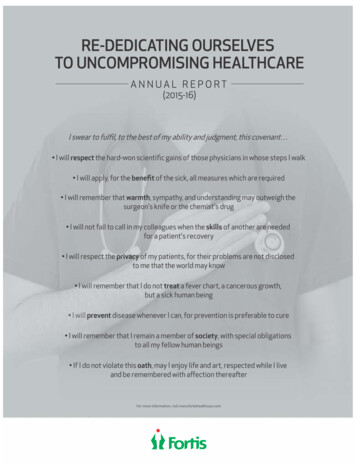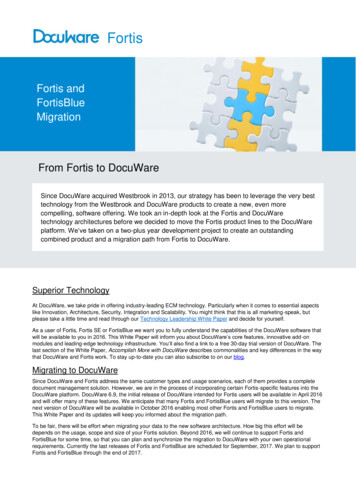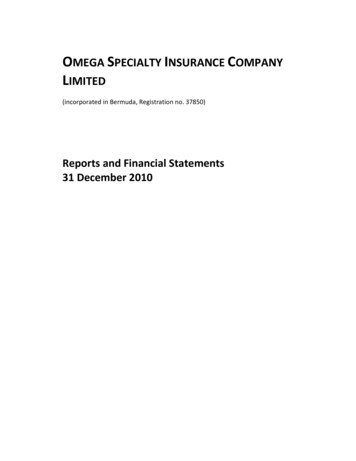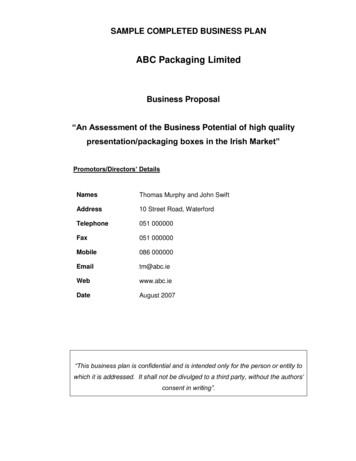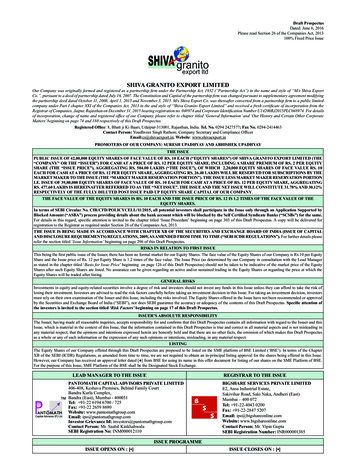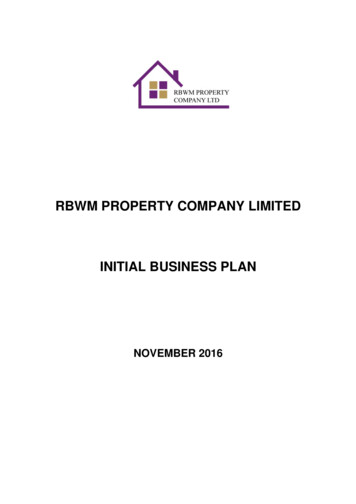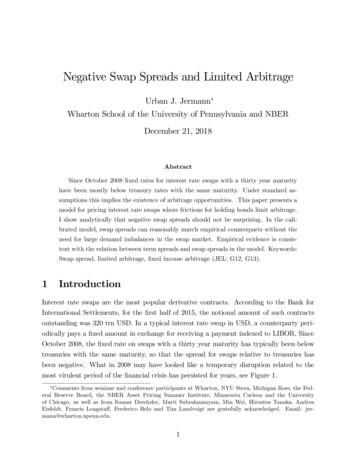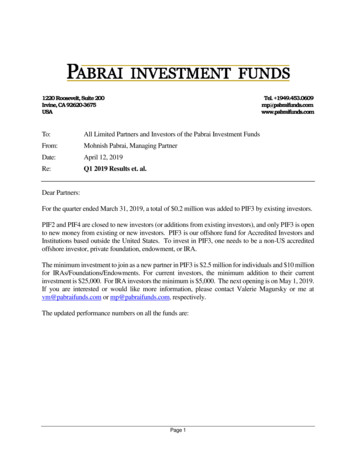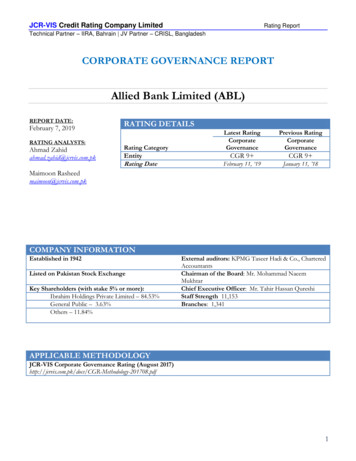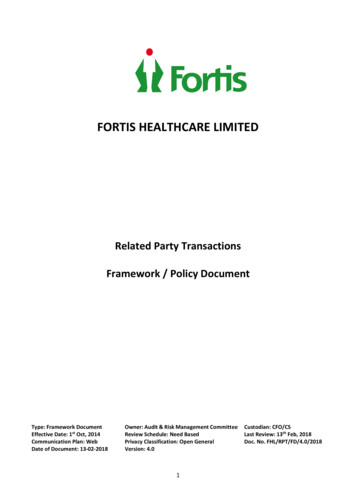
Transcription
FORTIS HEALTHCARE LIMITEDRelated Party TransactionsFramework / Policy DocumentType: Framework DocumentEffective Date: 1st Oct, 2014Communication Plan: WebDate of Document: 13-02-2018Owner: Audit & Risk Management CommitteeReview Schedule: Need BasedPrivacy Classification: Open GeneralVersion: 4.01Custodian: CFO/CSLast Review: 13th Feb, 2018Doc. No. FHL/RPT/FD/4.0/2018
INDEX1. Background 32. Objective .33. Legal Framework 34. Policy on Dealing with Related Party Transactions 4Process of Dealing with Related Party Transactions .55. Policy on Materiality of Related Party Transactions 66. Identification of Related Parties 77. Approval Protocols for Related Party Transactions .158. Disclosures w.r.t. Related Party Transactions 219. Annexures:(A) Templates Annexure A - Identification of Related Parties under CA2013 Annexure B - Identification of Related Parties under Ind AS24 Annexure C - Identification of Related Parties under Income TaxAct, 1961 Annexure D - Disclosure of Conflict of Interest by SMPs(B) SOP on Related Party Transactions2
Related Party Transactions1. BACKGROUNDRelated-party transactions (RPTs) refer to transactions between a company and its related entitiessuch as subsidiaries, associates, joint ventures, substantial shareholders, directors, KeyManagerial Personnel and their relatives, or entities owned or controlled by them.The Companies Act, 2013 which replaces the Companies Act, 1956, puts more responsibility andaccountability for the Board of Directors, Key Management Personnel (KMPs) to revamp and / orput systems and processes in place for compliance of legal requirements with regard to executionand approval of RPTs, on a continuous basis. The Securities and Exchange Board of India (SEBI) hasalso issued vide Notification dated September 2, 2015, SEBI (Listing Obligations and DisclosureRequirements) Regulations, 2015 which have replaced Equity Listing Agreement. The saidRegulations also specify certain obligations towards dealing with Related Party Transactions.These Regulations are effective from December 1, 2015.Accordingly, to ensure transparency and fairness throughout the entire process of undertakingrelated party transactions, with a view to safeguard the Company’s interests, Fortis has adoptedthe RPT SOP for the Fortis Group.2. OBJECTIVEThis document contains the Policy on Dealing with Related Party Transactions and the Policy onMateriality of Related Party Transactions. It has been framed in order to establish an agreedprotocol for identifying, assessing, approving and reporting Related Party Transactions and thatthe Related Party Transactions are carried out at arms’ length basis after obtaining necessaryapprovals and are reported in accordance with the disclosure requirements and best corporategovernance practices. This Document is supported by necessary templates and an SOP.3. LEGAL FRAMEWORK:-The Companies Act, 2013Indian Accounting Standard 24, issued by MCASEBI (Listing Obligations and Disclosure Requirements) Regulations, 2015The Income Tax Act, 19613
4. POLICY ON DEALING WITH RELATED PARTY TRANSACTIONSFortis Healthcare Limited (“FHL”) has adopted a system of “Pre-clearance” under a pre-decidedApproval Matrix for all proposed Transactions with such Related Parties as listed under thestatutory provisions or under FHL’s extended List of SMPs. Subsequent thereto necessarystatutory approvals – Audit & Risk Management Committee / Board of Directors / Shareholders,is sought, as the case may be.OMNIBUS APPROVAL BY AUDIT & RISK MANAGEMENT COMMITTEEa) In the case of frequent / regular / repetitive transactions which are in the normal course ofbusiness of the Company, the Audit & Risk Management Committee (“Audit Committee”) maygrant omnibus approval on the following criteria:i) The transaction are / shall be frequent / regular / repetitive in nature.ii) The transaction are / shall be in ordinary course of business and at arm’s length.iii) Such other criteria as may be laid down by the Audit & Risk Management Committee.b) While granting the approval the Audit Committee shall satisfy itself of the need for theomnibus approval and that the same is in the interest of the Company.c) The omnibus approval shall specify the following:i) Name of the related partyii) Nature of the transactioniii) Period of the transactioniv) Maximum amount of the transactions that can be entered intov) Indicative base price / current contracted price and formula for variation in price, if anyvi) Such other conditions as the Audit Committee may deem fit.d) Such transactions will be deemed to be pre-approved and may not require any furtherapproval of the Audit Committee for each specific transaction unless the price, value ormaterial terms of the contract or arrangement have been varied /amended. Any proposedvariations / amendments to these factors shall require a prior approval of the Committee.e) Further, where the need of the related party transaction cannot be foreseen and all prescribeddetails are not available, the Audit Committee may grant omnibus approval subject to thevalue per transaction not exceeding Rs.1,00,00,000/- (Rupees One Crore only).f) The details of such transaction shall be reported at the next meeting of the Audit Committeefor ratification.g) Further, the Committee shall on an annual basis review and assess such transactions includingthe limits to ensure that they are in compliance with the approval so granted.h) The omnibus approval shall be valid for a period not exceeding one financial year and freshapproval shall be obtained after expiry of such financial year.4
PROCESS OF DEALING WITH RELATED PARTY TRANSACTIONSRelated PartyTransactionsPre-Clearanceof RPTsMaterialTransactionsNon MaterialTransactionsOrdinary course ofBusiness and at Arm’sLengthAudit CommitteApprovalOmnibus ApprovalNot in Ordinarycourse of Businessand/or at Arm’sLengthUpto threshold limitAudit Committee Board ApprovalAudit Committee Board Shareholders'ApprovalExceeding thresholdlimitAudit Committee Board Shareholders'ApprovalSpecific ApprovalNotes: All approval referred above are prior approvals; ARM’s Length Transaction - a transaction between two RPs, conducted as if they were unrelated, so thereis no conflict of interest; and Material Transactions means the transaction as defined policy on materiality of related party transactions5
5. POLICY ON MATERIALITY OF RELATED PARTY TRANSACTIONSFortis Healthcare Limited recognizes that Related Parties Transactions can present an actual,potential or perceived conflict of interest and may run the risk of lack of adequate diligence toprotect interest of the Company and/or its shareholders.To safeguard the interests of the Company and /or its shareholders, Fortis Healthcare Limiteddefines the “Material Related Party transaction / transactions” to be entered into individually ortaken together with previous transactions during a financial year:as the value of which exceeds 10% of Annual Consolidated Turnover of theCompanyAll the “Material” Related Party Transactions shall be placed before the Shareholders.6
6. IDENTIFICATION OF RELATED PARTIES(I)Under the Companies Act, 2013Related Party1 includes:(i)(ii)(iii)(iv)(v)(vi)(vii)(viii)(ix)A ‘Director’ or his ‘Relative’,‘Key Managerial Personnel’ (KMP) or his ‘Relative’,A firm in which a Director / Manager or his Relative is a Partner,A Private Company in which a Director / Manager or his relative is a Member orDirectorA Public Company in which a Director / Manager is a Director and holds, alongwith2his Relatives, more than 2% of its paid-up share capital3,Any Body Corporate whose Board of Directors, Managing Director or Manager isaccustomed to act4 in accordance with the advice, directions or instructions (exceptgiven in professional capacity) of a Director or Manager;Any person on whose advice, directions or instruction (except given in professionalcapacity) a Director or Manager is a accustomed to act,Any company which is –(A) a holding, subsidiary or an associate company of such company; or(B) a subsidiary of a holding company to which it is also a subsidiarySuch other person as may be prescribed: A director (other than an independent director) or key managerial personnelof the Holding Company or his relative with reference to a Company.5The template for identification of Related Parties in line with theprovisions of Companies Act, 2013, is attached as Annexure A.Annexure ADefinitions under the Companies Act, 2013 Relative6With reference to any person, means anyone who is related to another, if—(i) they are members of a Hindu Undivided Family;(ii) they are husband and wife; or(iii) one person is related to the other in such manner as may be prescribed7: Father (includes step-father); Mother (includes step-mother); Son (includes step-son); Son’s wife; Daughter;1Section 2(76) of the Companies Act, 2013Note: “and holds, alongwith his relatives” signifies that the Director may not hold shares but if his relativeholds shares above the threshold limit, that will also be covered.3Note: Paid up share capital constitutes Equity Share Capital and Convertible Preference Share Capital4Note: For establishing that a person is “accustomed to act” in accordance with the advice of other, thereshould be series of events or a documentary evidence. A single isolated incidence or by virtue of a Holdingsubsidiary relationship doesn’t prove that one person is accustomed to act to the advice/instructions of other.5Rule 3 of Companies (Specification of definitions details) Rules, 20146Section 2 (77) of the Companies Act, 20137Rule 4 of Companies (Specification of definitions details) Rules, 201427
Daughter’s husband;Brother (includes step-brother) andSister (includes step sister). Key Managerial Personnel8In relation to a Company, means—(i)the Chief Executive Officer or the Managing Director or the Manager;(ii)the Company Secretary;(iii)the Whole-time director;(iv)the Chief Financial Officer; and(v)such other officer as may be prescribed Holding Company9Holding Company, in relation to one or more other companies, means a company ofwhich such companies are subsidiary companies; Subsidiary Company10“Subsidiary company” or “Subsidiary”, in relation to any other company (that is to saythe Holding Company), means a company in which the holding company –(i)controls the composition of the Board of Directors; or(ii)exercises or controls more than ½ (one half) of the “total11 share capitaleither at its own or together with one or more of its subsidiary companies;Provided that such class or classes of holding companies as may be prescribed shallnot have layers of subsidiaries beyond such numbers as may be prescribed.Explanation: for the purpose of this clause,-(a) a company shall be deemed to be a subsidiary company of the holding companyeven if the control referred to in sub-clause (i) or sub-clause (ii) is of anothersubsidiary company of the holding company;(b) the composition of a company’s Board of Directors shall be deemed to becontrolled by another company if that other company by exercise of somepower exercisable by it at its discretion can appoint or remove all or a majorityof the directors;(c) the expression “company” includes any, body-corporate;(d) “layer” in relation to a holding company means its subsidiary or subsidiaries. Associate Company128Section 2(51) of the Companies Act, 2013Section 2 (46) of the Companies Act, 201310Section 2 (87) of the Companies Act, 201311Note: “Total Share Capital” means: Equity Convertible Preference Share Capital12Section 2 (6) of the Companies Act, 201398
“Associate Company”, in relation to another company, means a company in which thatother company has a significant influence, but which is not a subsidiary company of thecompany having such significant influence and includes a joint venture company.13Explanation: For the purpose of this clause, “Significant Influence” means control of atleast 20% of the total share capital or of business decisions under an agreement. Control14Control shall include the right to appoint majority of the directors or to control themanagement or policy decisions exercisable by a person or persons acting individually orin concert, directly or indirectly, including by virtue of their shareholding or managementrights or shareholding agreements or voting agreements or in any other manner;(II)Under Indian Accounting Standard 24 issued by MCAA related party transaction is a transfer of resources, services or obligations between aReporting Entity (‘RE’) and a ‘Related Party’, regardless of whether a price is charged.A related party is a person or entity that is related to the entity that is preparing its financialstatements (referred to as the ‘Reporting Entity’ or ‘RE’).(A) A person or a close member of that person’s family15 is related to RE, if that person:(a) has control16 or joint control17 of the reporting entity(i) Individuals having power (contractual or otherwise) to direct RE’s relevantactivities to affect its variable returns(ii) Individuals holding (directly) more than 50% of voting rights in RE(iii) Individuals holding (jointly with any other person under contractual agreement)more than 50% of voting rights in RE(iv) Close members of family of above individuals:o that person’s children, spouse or domestic partner, brother, sister, fatherand mother;o children of that person’s spouse or domestic partner; ando dependents of that person or that person’s spouse or domestic partner.(b) has significant influence18 over the reporting entity(i) Individuals holding (directly) 20% or more of voting rights in RE(ii) Individuals holding (indirectly) through one or more entities controlled by them,20% or more of voting rights in RE(iii) Individuals holding 20% or more of voting rights in RE in combination of (i) or (ii)above(iv) Close members of family of above individuals:o that person’s children, spouse or domestic partner, brother, sister, fatherand mother;13Note: A combined reading of definition of Associate as well as Significant Influence suggest that all suchCompanies in which there is “direct / indirect holding” of more than 20% will be the Associate.14Section 2(27) of the Companies Act, 201315Please refer Definition # 2 in Definitions Section16Please refer Definition # 3 in Definitions Section17Please refer Definition # 7 in Definitions Section18Please refer Definition # 8 in Definitions Section9
oochildren of that person’s spouse or domestic partner; anddependents of that person or that person’s spouse or domestic partner.(c) is a member of Key Management Personnel19 of RE or of a parent of RE(i) Chief Executive Officer, Chief Financial Officer, Company Secretary, Manager ofRE(ii) Board of Directors (Executive / Non-Executive) of RE(iii) Any person in accordance with whose directions or instructions the Board ofDirectors of RE is accustomed to act(iv) Chief Executive Officer, Chief Financial Officer, Company Secretary, Manager ofParent of RE(v) Board of Directors (Executive / Non-Executive) of Parent of RE(vi) Any person in accordance with whose directions or instructions the Board ofDirectors of Parent of RE is accustomed to act(vii) Close members of family of above individuals:o that person’s children, spouse or domestic partner, brother, sister, fatherand mother;o children of that person’s spouse or domestic partner; ando dependants of that person or that person’s spouse or domestic partner.(B) An entity is related to a reporting entity if any of the following conditions applies:(a) The entity and the reporting entity are members of the same group20(i) Holding Company (immediate, Intermediate and Ultimate)21 of RE(ii) Subsidiaries (including step subsidiaries) of RE(iii) Other Subsidiaries of Holding Company (including step subsidiaries) of RE(b) One entity is an associate22 or joint venture23 of the other entity (or an associate orjoint venture of a member of a group of which the other entity is a member).(i) Entities in which RE (directly) holds 20% or more of the Voting Power(ii) Entities which (directly) hold 20% or more of Voting Power in RE(iii) Joint Ventures of RE(iv) Joint Venturers of RE (if RE itself is a Joint Venture Entity)(v) Entities in which Parent Entity of RE (directly) holds 20% or more of the VotingPower(vi) Entities in which Subsidiaries of RE (directly) holds 20% or more of the VotingPower(vii) Entities in which subsidiaries of Parent Entity of RE (directly) holds 20% or moreof the Voting Power(viii) Entities which (directly) hold 20% or more of Voting Power in Parent Entity of RE19Please refer Definition # 5 in Definitions Section.The definition of Key Managerial Personnel has been extended to cover KMPs defined under the provisionsof Companies Act, 201320Please refer Definition # 4 in Definitions Section [Group means Parent, Subsidiary(ies) and FellowSubsidiary(ies)]21As per Clause 13 of Ind AS 24, an entity shall disclose the name of its parent and, if different, the ultimatecontrolling party22Please refer Definition # 1 in Definitions Section23Please refer Definition # 7 in Definitions Section10
(ix) Entities which (directly) hold 20% or more of Voting Power in Subsidiaries of RE(x) Entities which (directly) hold 20% or more of Voting Power in Subsidiaries ofParent Entity of RE(xi) Joint Ventures of Parent Entity of RE(xii) Joint Ventures of Subsidiaries of RE(xiii) Joint Ventures of Subsidiaries of Parent Entity of RE(xiv) Joint Venturers of Parent Entity of RE(xv) Joint Venturers of Subsidiaries of RE(xvi) Joint Venturers of Subsidiaries of Parent Entity of RENote24: Associate includes subsidiaries of the associate and a Joint Venture includessubsidiaries of the joint venture.(c) Both entities are joint ventures of the same third party.(i) In case RE itself is a Joint Venture Entity, then all other Joint Venture Entities of itsJoint Venturers(d) One entity is a joint venture of a third entity and the other entity is an associate ofthe third entity.(i) In case RE itself is a Joint Venture Entity, then all Associates of its Joint Venturer(s)(ii) In case RE itself is an Associate of an Entity, then all Joint Ventures of such Entity(e) The entity is a post-employment benefit25 plan26 for the benefit of employees ofeither the reporting entity or an entity related to the reporting entity. If thereporting entity is itself such a plan, the sponsoring employers are also related tothe reporting entity.(i) Any Provident / Pension / Superannuation / Insurance / Medical Care Fund Trustfor the benefit of employees of RE or for the employees of any other related entityof RE(ii) If RE itself is such a Plan – then Sponsoring Employer(f) The entity is controlled or jointly controlled by a person identified in (A) above*[*Identified Individuals)(i) Entities in which Identified Individuals having power (contractual or otherwise) todirect their relevant activities to affect its variable returns(ii) Entities in which Identified Individuals hold (directly) more than 50% of votingrights(iii) Entities in which Identified Individuals hold (jointly with any other person undercontractual agreement) more than 50% of voting rights(g) A person identified in [(A)(a)] has significant influence over the entity or is a memberof the key management personnel of the entity (or of a parent of the entity)**.[**Distinguished Individuals](i) Entities in which Distinguished Individuals hold (directly) 20% or more of votingrights(ii) Entities in which Distinguished Individuals hold (through one or more entitiescontrolled by them) 20% or more of voting rights24Clause 12 of Ind AS 24Please refer Definition # 11 of Definitions Section26Please refer Definition # 10 of Definitions Section2511
(iii) Entities in which Distinguished Individuals hold 20% or more of voting rights incombinat
Fortis Healthcare Limited recognizes that Related Parties Transactions can present an actual, potential or perceived conflict of interest and may run the risk of lack of adequate diligence to protect interest of the Company and/or its shareholders. To safeguard the interests of the Company and /or its shareholders, Fortis Healthcare Limited
